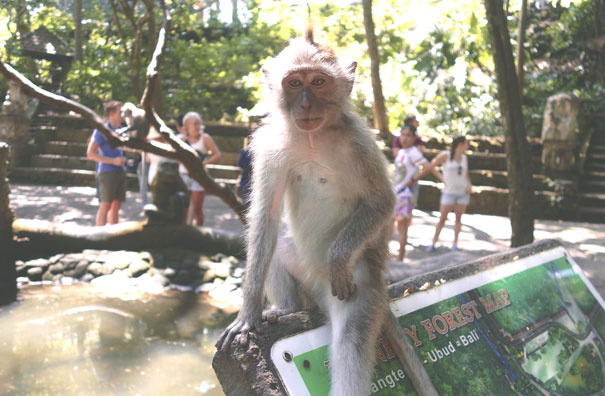
Ketut Suartana has done well out of Bali’s tourism boom. His guesthouse in Ubud is regularly booked up and he’s in the process of building another one just up the road. But, Ketut and others benefitting from the influx of visitors are increasingly aware that the changes brought to the island by mass tourism risk undermining its social fabric, and leaving its people heavily dependent on one unpredictable industry.
Bali’s appeal to honeymooners, Australian sun seekers and Americans in search of spiritual fulfilment is no new phenomenon – and the once largely agrarian island has done well out of its tourists over recent decades, with economic growth outstripping that in many other parts of Indonesia.
But the arrival of growing numbers of visitors from an increasingly diverse range of countries is testing Bali’s capacity to absorb them and risks sullying the attractions that take them there in the first place, as well as eroding the cultural traditions that provides the glue which holds society together.
The number of foreign visitors to Bali soared by more than 90 per cent between 2008 and 2014 to reach 3.8 million people – not much less than the island’s resident population. That’s an impressive performance for an industry that suffered following high-profile terrorist bombings in tourist hotspots in 2000 and 2005, and there is no sign that the rate of increase is slackening off.
It’s not hard to see why. This is a tropical island with a bit of everything: the surf beaches of gaudy Kuta (which has something of the same cheap beach holiday appeal for Australians that Spain’s Costa del Sol or Balearic Islands provide for northern Europeans), high end resorts for wealthier foreigners, impressive temples, the new age vibe of the island’s “cultural capital” Ubud, spectacular volcanic scenery, eco-tourism and great places to dive and snorkel.
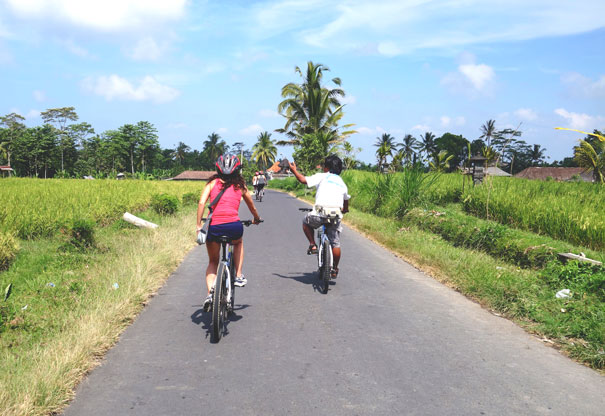

Hippies and Australian backpackers may have pioneered modern tourism, but now Bali attracts visitors from all over the world and all budgets. A new wave of Chinese and Russian tourists are mingling with their western and Japanese counterparts, as the increased earnings of the new Beijing and Moscow middle classes stretch to foreign travel.
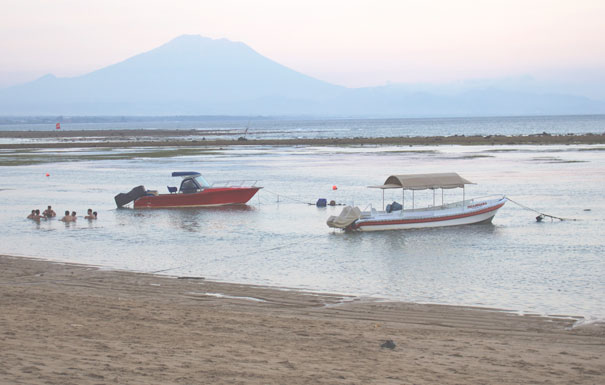
The Balinese generally succeed in meeting the expectations of their visitors, but development is coming at a cost. Water resources are under pressure, power blackouts still remain common – though on the wane thanks to new Chinese-financed coal-fired power stations – rubbish gets dumped in picturesque river valleys, roads across the more populated south of the island are frequently clogged with traffic.
Meanwhile, some of the island’s iconic cultural attractions are falling victim to their own popularity. Any of the spiritual ambience that Ubud’s Sacred Monkey Forest temple complex may have had has been largely expelled by the sheer weight of numbers of daytrippers from coastal resorts excitedly snapping the antics of the local macaques.
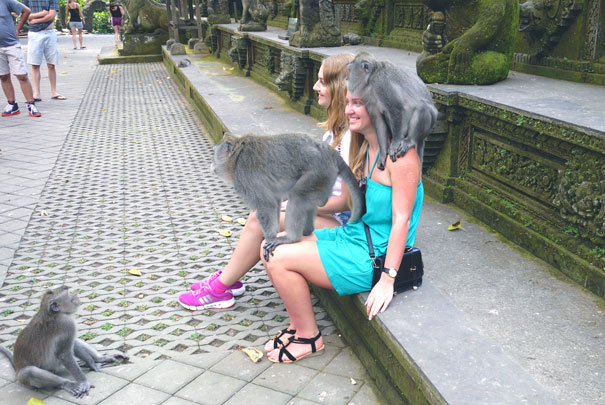
Those seeking the self-revelatory experiences that Julia Roberts’ character finds in Ubud in the bewilderingly popular film (and book) Eat Pray Love – which reportedly helped feed the town’s tourism boom – may struggle to do so. As they walk out into the rice fields around the town, birdsong and the sound of the breeze rustling through the trees may come off second best to the noise of hammering from construction work on a rash of new villas and hotel rooms being built to cater for foreign demand.
As Ubud-based photographer and writer Rio Helmi has noted, this is more than just an issue of aesthetics. Inherited farm land is closely associated in Balinese culture with spiritual well being and family unity, as well as providing the traditional mainstay of the economy. So its sale to foreign owners marks a distinct cultural change, while also leaving families who sell up without a fallback, if the tourist industry falters.
Ketut Suartana, who owns Ketut’s Place, a long-standing and successful Ubud guesthouse, says few younger Balinese, outside the less touristy rural areas of northern Bali, have the skills or interest to work the land.

Ketut's place
“I worry about what will happen in the future, if everyone wants to be a taxi driver or work in a hotel. Not many young people start off as farmers anymore. Not many people know how to sow rice,” he says. Ketut believes that when his uncle retires from farming the family’s land – both men are in their fifties – there will be no one from the extended family to take over.
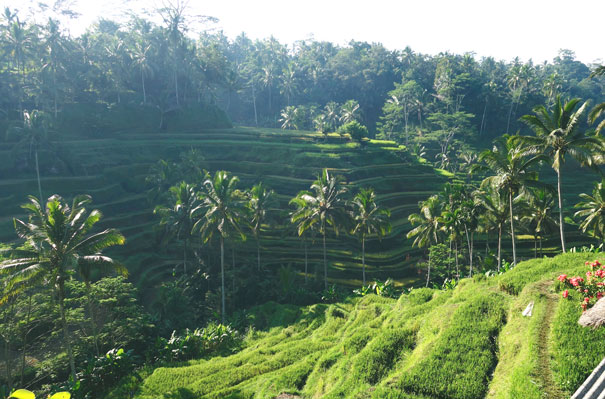
Rice terraces
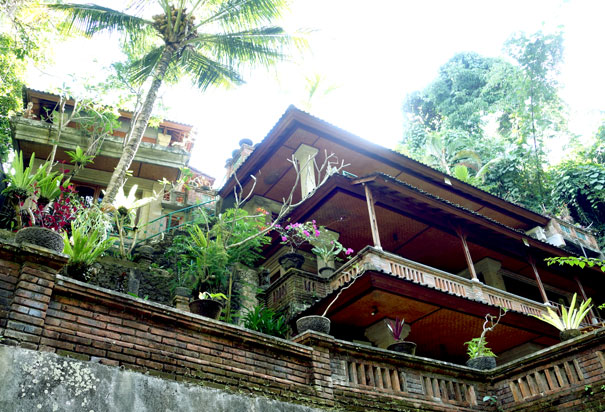
Local arts and crafts are also suffering. The wood carvings, basketwork and traditional paintings that fill the tourist shops of Ubud and the resorts around the capital Denpasar now mainly come from the northern villages rather than local crafts people. “It’s just a few people of my age doing the wood carvings. In Ubud, people just collect and sell” Ketut says.
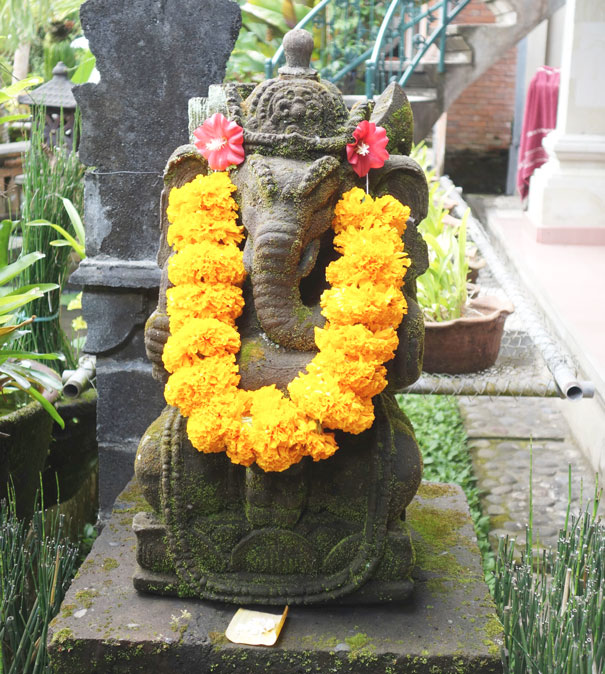
Statue in Ketut's garden
Of course, there is no reason to expect the Balinese to remain tied to their rice fields and traditional crafts just to provide eye candy for tourists and for those who have managed to make a success out of the tourism industry, there is a considerable upside.
Ketut started off his working life as a rice farmer, but, since 1989, he has steadily built up a viable tourism business around his 16-room traditional homestay guesthouse. The income from that has helped fund university educations for his four children, who include a doctor and a dentist. He and his son are now working on a second guesthouse to provide economic security for the family in future.
However, he retains a pragmatic attitude towards prospects for the tourist industry perhaps informed by the uncertainties of farming in his youth. Steady progress on building the second guesthouse is being funded by the profits made from the existing one, rather than through borrowing which might have speeded up the process. “I don’t want to get a bank loan for the new place, because we don’t know how long business will remain good,” Ketut says.
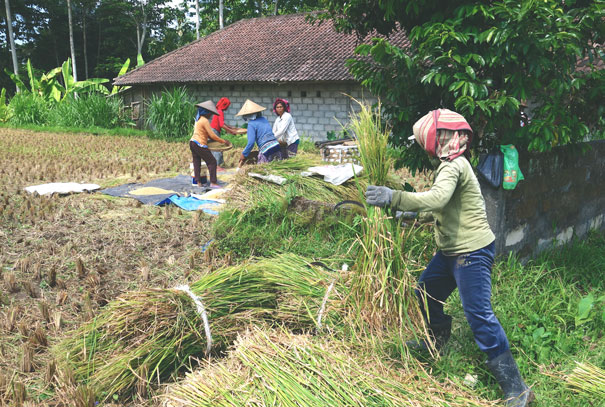
Rice farming
Higher incomes have been accompanied by higher prices and, Ketut reckons, lower quality food, as local fresh food is replaced by imports from the rest of Indonesia and elsewhere. “People have more money than 30 years ago, but they still had a good life then too,” he says.
For now, there’s plenty to keep the visitors flocking to Bali – few holiday destinations can offer such diverse attractions in a relatively small area (the main island is around 110km by 150km), or such hospitality. But the island’s authorities face a stiff challenge if they are to successfully cater for ever-rising tourist numbers, while retaining the unique character of Bali’s culture and geography.